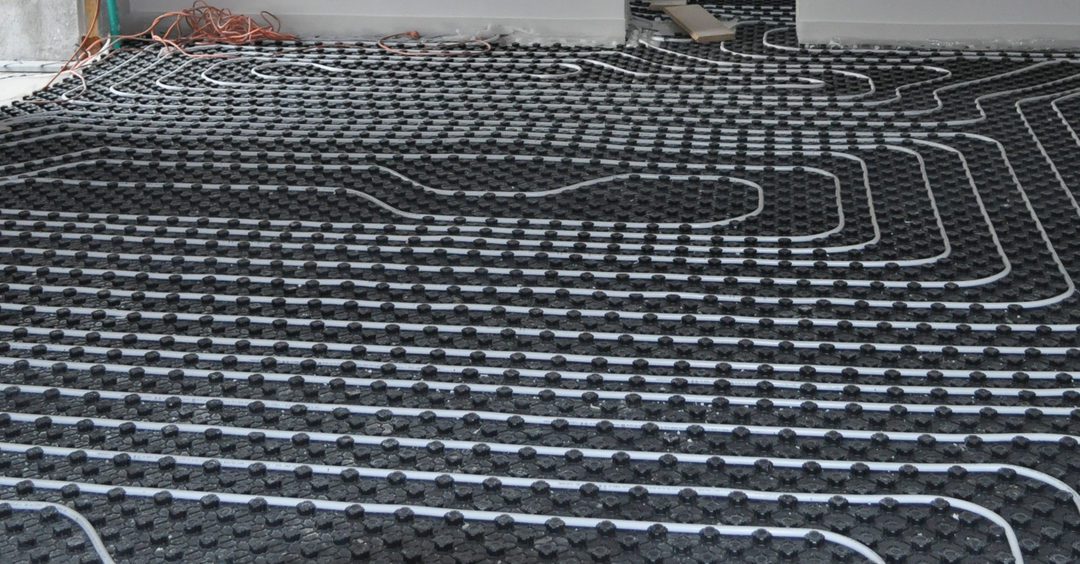It’s winter across America, and it’s 7 am. You’re wrapped up in bed, but you know that you have to peel yourself away because you have a list of errands to run. It’s difficult knowing that as soon as you place your feet on the floor, your whole body will feel the wrath of winter. You can avoid this scenario and embrace the experience of waking up early on a cold morning with radiant heating.
Radiant Heat is an Effective System That Warms the Entire Home
Feeling the warmth from your hardwood floor in the bedroom and from the ceramic tiles in the kitchen isn’t a miracle—it’s a benefit of radiant heat. Homeowners considering heating solutions have probably asked themselves, what is radiant heat, and how exactly does it work? We’ll discuss everything that you need to know to decide whether this system is ideal for you.
When you step out into a bright winter’s morning, you immediately feel the heat of the sun on your body, which is radiant heat. Gas and electric furnaces or air conditioners heat the air in a room, but a radiant heating system warms up everything in your home. Radiant heating systems feed heat directly to the floor or panels in the wall. The process involves heat transfer directly from a hot surface to the individuals or objects in a room via infrared radiation. Another example of this heating system is turning on the stove during a cold day and feeling the rest of the house warm up because of its radiant heat.
The concept of radiant heating systems isn’t new: it dates to when ancient Romans first used hot water pipes to warm their floors. Flash-forward to 1970s Europe, and you’ll see citizens beginning to adopt this method of heating at scale. Whether you’re building a new home or upgrading an older one, you can capitalize on this system. There are two primary types of radiant heating systems to understand: hydronic and electric.
The Difference Between Hydronic and Radiant Heating
Hydronic systems pump heated water from a boiler to tubing in a pattern under your flooring. Some systems use zoning valves to control the flow of hot water through each tubing loop.
Electric radiant systems comprise electric heating cables underneath the floor. Due to the costs associated with electricity, this option is typically only cost effective when you include a thermal mass such as a concrete floor. Your utility company should offer time-of-use rates that allow you to warm up the concrete floor during off-peak hours. In this case, the floor should be large enough to hold the heat for close to ten hours without consuming more electricity.
Regarding floor coverings, ceramic tiles are the most effective for radiant floor heating. This material conducts heat well and adds a degree of thermal storage. Other coverings, such as vinyl, carpets, wood, or linoleum, can still be effective, but any covering that insulates the floor from the room will render the system ineffective. Try to use thin carpets if you prefer carpet as a covering, and instead of hardwood flooring, opt for laminated wood flooring, which supports the efficiency of the radiated heat.
Is a Radiant Heating System for You
If you’re still pondering whether a radiant heating system is for you, understanding the benefits might convince you.
Radiant heating is far more energy efficient than baseboard heating and forced-air systems. Since there is no need to rely on ducts, this system eliminates the possibility of air loss. Some forced-air systems can distribute allergens, but radiant heat doesn’t come with this concern.
If you’re using the hydronic system, you’re operating completely independent of electricity, which means that you’ll save on your utility bill. Hydronic systems can use multiple energy sources to heat the water, such as gas or wood boilers, solar water heaters, or a combination of these options.
Radiant heating systems require little effort to operate at peak conditions for several years. Some systems include a 30-year guarantee, which is enough to give any homeowner peace of mind that they won’t be without a proper heating system in the winter. You can include a programmable thermostat to warm up your home only at specific times—for instance, in anticipation of your arrival home from work.
With this system, you can enjoy additional livable space with your heating system tucked underneath the flooring. Radiators often occupy a fair degree of space in a room, but with heated floors, you have complete control over the design of your interior.
These systems are safe for occupants, and you won’t have to worry about visitors navigating around the corners of radiators or accidentally touching hot surfaces. You can tuck radiant heat systems away from sight while keeping them highly effective for the times when you require their services.
Radiant heat is a plus for your air quality since it keeps breathable air rich in oxygen. Because these systems don’t need to heat the air, they won’t stimulate dust particles, which may rise with forced-air systems.
With these factors in mind, you can engage a professional HVAC technician to survey your home and make recommendations regarding radiant heating. With your new system in place, you can wake up every winter morning confident in your home’s heating capabilities and ready to embrace what lies ahead.

